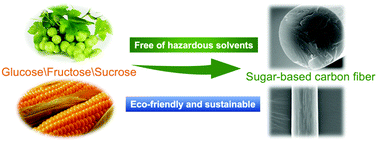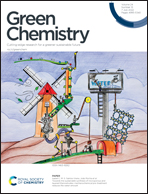Eco-friendly and sustainable approach of assembling sugars into biobased carbon fibers†
Abstract
Carbon fibers (CFs) are normally manufactured from synthetic or biomass polymers. However, the synthesis and spinning of traditional polymer precursors inevitably requires the use of a large amount of hazardous solvents, resulting in high extra cost and pollution from the production of CFs. Herein, sugars were used as brand-new CF precursors in an eco-friendly and sustainable approach, obviating the need for hazardous solvents. This strategy involves the synergy of sugars and double-network hydrogels. The hydrogel network provided a high-stress environment to control the carbonization of the sugar, effectively inhibiting the generation of gaseous and volatile products; meanwhile the sugar prevented the deformation of the network. As a result, the carbon yield improved substantially, reaching values of ∼50%, significantly reducing carbon emissions. Thus, the SBCFs have a compact and homogeneous microstructure, along with excellent mechanical properties. The tensile strength and Young's modulus of the SBCFs were found to be 960 MPa and 77 GPa, respectively. Moreover, the precursor cost of SBCFs was only 1/10 that of traditional biobased CFs, offering the opportunity to improve both the sustainability and overall economics of bio-based CF production.

- This article is part of the themed collection: 2022 Green Chemistry Hot Articles


 Please wait while we load your content...
Please wait while we load your content...